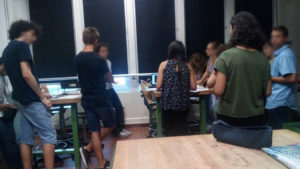 The recurrence in Trieste activities of the role of waves in physics motivated us to develop a more in-depth activity on waves. For this reason, we asked the Young Minds Project to finance the building of an educational model of spectrometer. Such spectrometer fits in a larger educational/outreach unit, in which we present to students and the general public the spectral analysis of waves.
The recurrence in Trieste activities of the role of waves in physics motivated us to develop a more in-depth activity on waves. For this reason, we asked the Young Minds Project to finance the building of an educational model of spectrometer. Such spectrometer fits in a larger educational/outreach unit, in which we present to students and the general public the spectral analysis of waves.
The concept of spectrum and of Fourier analysis is first introduced with a well-known object, the tuning fork. With the aid of a smartphone app, it is possible to show various aspects of sound waves, like the origin of harmonics and the spectrum of the human voice.
After the introduction of the concepts via sound waves, the spectral analysis of light allows to introduce more advanced concepts. A spectrometer allows, in fact, to see that not all light that appears as white is the same. Light from a light bulb, from a smartphone flashlight, or from discharge lamps can be shown to be different, introducing the concept of quantized energy levels in the atoms, in analogy with the discrete spectrum of a tuning fork.
This outreach unit was used for the first time in the context of a week-long college fair for 32 high school students visiting the Physics Department. In that occasion, we could use a spectrometer borrowed from a laboratory, to show the students how the spectra from the various sources look like. Afterwards, the students measured the spectrum of mercury with the home-built educational spectrometer, which is composed by a prism and a photodiode on a mechanical translator. Such rudimentary spectrometer is very useful from an educational point of view, since it allows the students to identify the key aspects in the measurement of a spectrum, such as a collimated incoming light beam and darkness in the lab. During the activity, the students were asked to answer a set of questions.
On the basis of our simple spectrometer, we are now supervising a high school student in her final-year project, for which she is building a more advanced educational spectrometer, whose draft layout is reported in the picture. This consists of a diffraction grating obtained from a DVD and a webcam sensor. While this spectrometer will be a closed-box instrument and will not be a hands-on object like the one described above, it allows to rapidly measure spectra. In the context of this student’s project, it will be used to measure the spectrum of differently coloured leaves.
We are also setting up a collaboration with a school in our region to prepare an experimental educational unit for high school students on thermal radiation and on the quantization of the atomic energy levels. Our estimate is that this will make us indirectly reach 40 students per year, since the class will be repeated every school year.
Finally, we are designing an object to illustrate the phenomenon of diffraction by a lattice. In particular, a lattice made of air balloons can produce a sound-waves diffraction pattern, in which people can literally walk.
